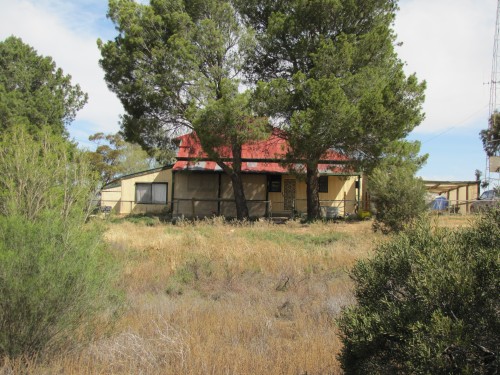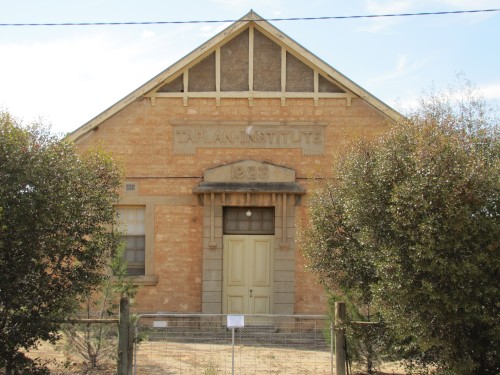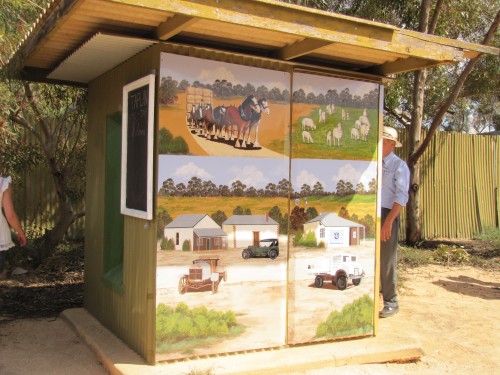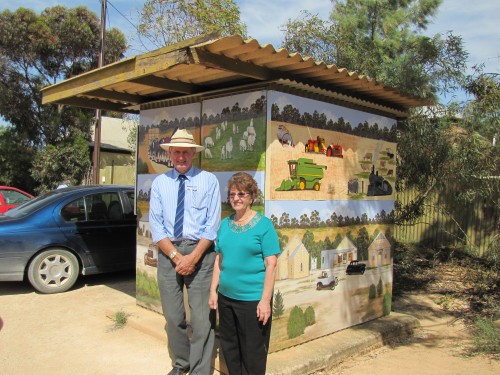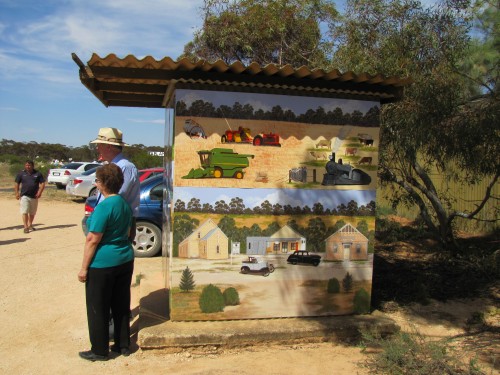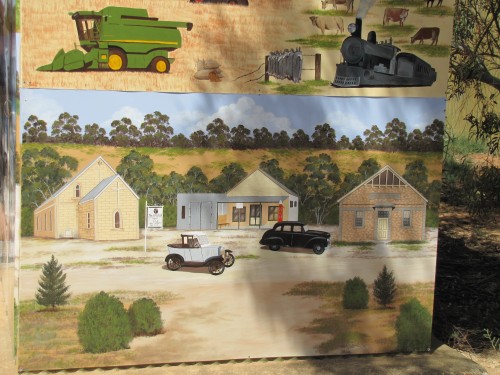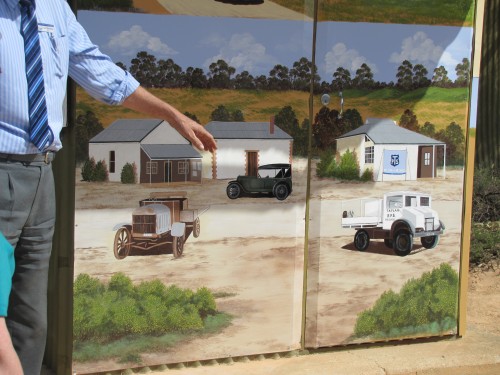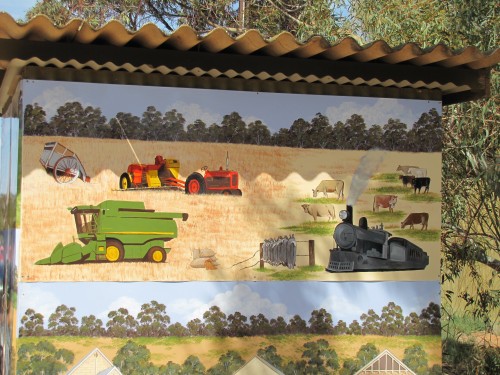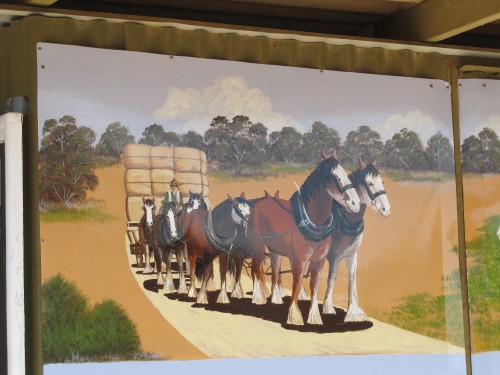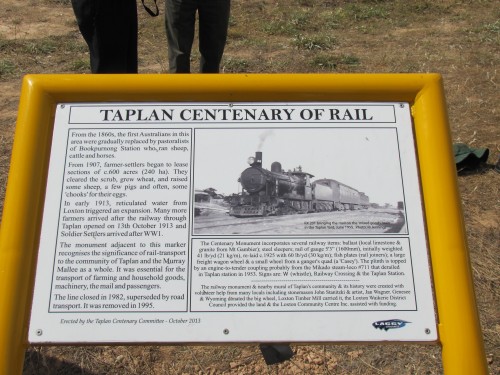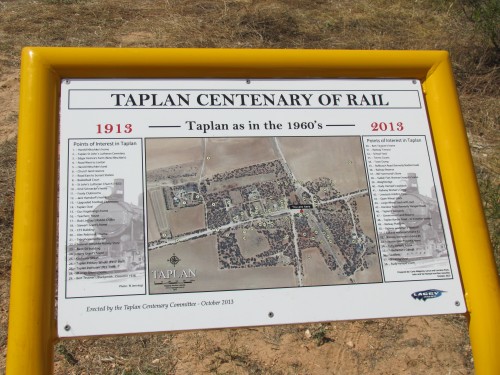Taplan Primary School
During the Taplan Railway Centenary celebrations in October 2013, I took a wander through the small town where I grew up in the 1950s and 60s. One of the buildings which took some of my attention was the former Taplan Primary School, now a private residence, shown in the photo above. Taplan is a small town some 30km south-east of Loxton, in the Murray Mallee region of South Australia and only 8km from the Victorian border.
This school opened in the early 1900s but I am not sure when it closed, possibly in the 1970s. I can’t find any references to its year of operating online but I do have a history book on the town at home – but I am writing this in Sydney – two days’ drive away. (I will update this next week.) Update: The school shown in the photo above opened in 1927 and closed in 1967. Previously a school was conducted in the galvanised iron room at the back of the Institute Hall from 1917 until 1928.
When I attended the school in the 1950s this was a thriving school with – if my memory serves me correctly after all these years – an enrolment of between 30 and 40 children. I seem to remember that it catered for even more before I started, but numbers gradually dwindled to fewer than a dozen before closing permanently. For most of the time, the school operated it employed only one teacher for all seven grades in the one room. For a brief period during my schooling, there was a part-time second teacher, who just happened to be a second cousin.
The school population came from the few houses in the town and the families of the workers on the railway maintenance gangs. By far the bulk of the students, however, came from the surrounding farming community. As farms were amalgamated families moved elsewhere. Other families chose to send their children by bus to the schools in Loxton, especially the newly opened Lutheran School. This eventually caused small schools like Taplan to close.
I have many fond memories of my days in primary school. My teacher, Mr Peter Evans, was in fact, the only teacher I had during my entire primary schooling. I enjoyed his style of teaching so much that he inspired me to become a teacher. I served in a variety of South Australian schools for 35 years until my retirement in 2004. He inspired a lifelong love of learning, reading and the environment.
The school grounds were extensive, with a large gravel covered play area which hosted many great cricket and football matches. The playground equipment was basic: 2 swings, a large see-saw, a zig-zag and some monkey bars for climbing. The lack of equipment did nothing to quell our imagination, though. The playground extended into a 5 acre (2ha) patch of mallee scrub, a great place for adventures of all kinds, from hide-and-seek through to pirates and western sagas and the occasional mini world war. Like most children we let our imaginations soar in all directions, creating games on the run.
Next to the main playground the parents’ association had created a vegetable garden. We had regular lessons in gardening and each student had their own plot to grow whatever they liked. I loved growing carrots, beetroot, turnips and a range of other vegetables. When I picked the results of my labours I was so proud taking home the produce for the family to eat. These skills carried over to the home patch of vegetables where I regularly helped my mother. Strangely, this early interest in growing vegetables has not fully extended into my adult life, except the times when I help my wife in the garden. I still enjoy working in the garden – as my back allows – but it seems not to be a high priority these days.
One last memory of my time at this school: the 40-metre strip of roadside verge between the main street and the school property was the scene of an annual tree planting ceremony. On Arbor Day many of us would plant a new tree or shrub in this nature strip. For many years this plantation thrived and made a great addition to the local town environment. Since the school has closed this plantation has deteriorated through neglect. Many of the trees have also died out through lack of watering; the Taplan summers can be very hot and dry and some trees were inappropriate for the region’s climate.
Updated 30th December 2016.
Taplan Institute Hall
I took this photo on the occasion of the Taplan Railway Centenary celebrations in October 2013. I have written extensively about this event in recent posts.
Taplan is a small Murray Mallee farming community south of Loxton in eastern South Australia. In the 1950s and 60s, I grew up on a wheat and sheep farm just over a kilometre from this spot. Taplan Primary School, which I attended for 7 years, is barely a hundred metres up the street from this point.
The Taplan Institute Hall, opened in 1923, is now a private home but in its heyday, along with the local Lutheran Church, was the hub of community activities. The hall was used for many functions, including concerts, weddings, parties, regular dances and the very popular annual Strawberry Fete. Update: a galvanised iron room at the back served as a school from 1917 until the new school opened in 1928 just up the main street.
Taplan Strawberry Fete:
As a child, I always looked forward to this wonderful event, usually held in November of each year if my memory is correct. While the fete was also a dance evening, there were plenty of soft drinks and games for the children, and lashings of strawberries and ice-cream or strawberries and cream for everyone. It was a gastronomic delight. While strawberry fetes are mostly a thing of a wonderful past there are still a few communities which hold such delightful feasts in rural areas.
School Concerts:
Another annual event held in the Taplan Institute Hall was the end of year School Concert. For many weeks leading up to the end of the school year, we would be taken through our paces, practising songs, plays, recitations and even an occasional dance. Around the walls of the hall we set up trestle tables with examples of our best school work achieved through the year: artworks, writing, maths, handiwork and so on. The boys displayed items made in woodwork and the girls displayed their knitting. Remember – in the 1950s some activities were still very much either boy-centred or girl-centred.
One last thing. During my primary schooling at Taplan, I had the one teacher throughout my 7 years there. During the last few years of my schooling there, his wife attempted to teach me how to play the piano. I was coerced into playing several pieces solo at the end of year concert. I still flinch a little at the embarrassing memory of stopping part way through one piece, but being brave enough to start over and complete the song.
Updated 30th December 2016.
Taplan mural paintings
As a part of the Taplan Railway Centenary celebrations in 2013 there was special mention made of the new murals painted on the telephone exchange building. This small structure, shown in today’s series of photos taken on the day, replaced the old manual telephone exchange in the nearby post office many years ago. This building also doubles as a mail centre, the letters being sorted regularly into a handful of post office boxes in the side of it.
When I was growing up in the 1950s and 60s I would walk past this spot twice every day on my way to and from school a few hundred metres away. Behind this modern structure is the old post office where I would stop every day on my way home to collect the mail from a window, behind which the post master sat. His job every day would be to sort the few dozen letters addressed to residents in the area. He also manned the manual telephone exchange, connecting incoming calls to the number being called.
The phones in the homes of the district were typical of many used throughout rural Australia of that era. A bulky wooden cabinet hung on the wall in our dining room, with a large mouthpiece and a cord attached to an earpiece. When there was an incoming call, the phone would ring loudly and to answer one picked up the ear piece from its cradle and spoke into the mouthpiece. The person manning the exchange then connected the caller. To make a call one would pick up the earpiece and turn a handle, alerting the person in the exchange that you wanted to make a call, which they then connected for you. My parents would be astounded by the modern mobile phone and the many things one can do on one.
In the photos below I have show the new murals from different angles. One photo shows the artist and the Mayor of Loxton Waikerie who declared the murals open. The paintings, based on local scenes and local farming equipment down through the years, show typical scenarios of life in the Taplan region.
Taplan Railway Centenary Celebrations part 6
This interpretive sign was placed in position near the plaque celebrating the centenary of the opening of the railway line through Taplan, south east of Loxton in eastern South Australia. (Click to enlarge the image.)
The Taplan area in the Murray Mallee region of my state is a predominantly cereal growing area, supplemented by sheep and cattle. The opening of the railway line in 1913 accelerated the growth of the town and the surrounding farms. Its introduction meant quick access to markets for the products produced, as well as easy transport of farming supplies needed.
When I was growing up on my father’s farm in the 1950s and 60s, the town was still a busy community. Every day on my way to school and home again I would walk past this very spot where these signs now stand. The school was a one room, one teacher rural school with about 30 children attending. It closed many years ago and the few children left in the community now go to school in Loxton by bus.
The interpretive sign shown in the photo below shows an aerial photo of Taplan taken in the 1960s. It shows my father’s farm homestead in the lower right hand corner of the photo. Our farm is shown as the cleared land in the lower part of the photo – of course, this was only a small portion of the whole farm which stretched several miles in either direction east and west of the town, and about a mile to the south, some 2000 acres in all.
